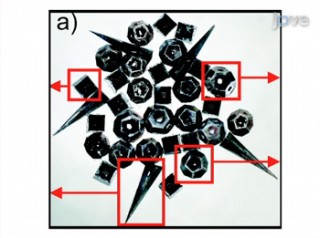Feb 14 2013
The nanotechnology research space is rapidly growing, with vast implications for the healthcare, consumer electronics, surveillance, and defense industries. However, a major limitation to this research is the ability to create particles that vary in shape and function on a micrometer or nanometer scale.
 Some of the possible shapes made from Dr. Gracias' self-folding particles. Credit: Jove.com
Some of the possible shapes made from Dr. Gracias' self-folding particles. Credit: Jove.com
To overcome these limitations, chemical engineers at Johns Hopkins University have developed self-assembling particles that are inspired by origami, the traditional Japanese art of folding paper into complex three-dimensional shapes. A new article in JoVE (Journal of Visualized Experiments) demonstrates the fabrication and folding of these particles.
"In this video-article, we take the idea of folding up particles and demonstrate the technology in two applications. In the first application, the particles seal up because of glue like material at the edges. In the second part, we talk about structures that reconfigure in response to a stimulus," said author Dr. David Gracias of Johns Hopkins University in Baltimore, Maryland.
Dr. Gracias uses a process called photolithography to etch structural designs and flexible hinges on to a 2-D surface. When these complex patterns are exposed to the correct environmental pressures, they can be manipulated to fold and seal or open and close. This fabrication process also allows crucial structural patterns to be printed on 3-D particles, as Dr. Gracias explains: "Patterns are required for electronic circuits, and we allow patterns to be used in 3-D. The applications are numerous, ranging from drug delivery to mechanical sensing, bio-sensing technologies applicable to threat detection, surveillance, and in non-invasive surgery or biopsies."
The authors believe that the applications of this technology are far reaching, and that video publication in JoVE will expedite its adoption by other scientists. "We have developed a new platform, like welding, and we hope that publishing the video will make it more likely for others to use this platform," Dr. Gracias explains. He continues, "One of the concerns with chemistry is that most chemists work with models which cannot be seen. Animation and videos published in JoVE will make these models much easier to understand."
This video article is published in JoVE Chemistry, the newest section of JoVE that was launched in February 2013. "This article really underscores why we chose to open JoVE Chemistry," said Associate Editor Rachelle Baker about Dr. Gracias' article. She continues, "Not only is chemistry a fundamental science but it is a meeting point for interdisciplinary research with bioengineering and physics as well. A video protocol that can enable 2D patterning onto 3D particles of various sizes will be widely applicable to other studies in various disciplines."
Source: http://www.jove.com/